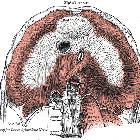Perikard

desc}} ==
{{Gray"s Anatomy plate}} == {{int:license-header}} == {{PD-US}} [[Category:Heart (organ)]] [[Category:Media missing infob

Pericardium
• Pericardial sinuses (Gray's illustration) - Ganzer Fall bei Radiopaedia
The pericardium is a conical, flask-like, fibroserous sac which contains the heart and the roots of the great vessels and defines the middle mediastinum.
Gross anatomy
The pericardium is made of two sacs in one. The outer sac is the fibrous pericardium and the inner sac is the double-layered serous pericardium. Layers of serous pericardium are divided by the pericardial space, which only contains 15-50 mL of serous fluid. Each layer has quite different structure and functions (from external to internal):
- fibrous pericardium: tough connective tissue continuous with and bound to the central tendon of the diaphragm (pericardiophrenic ligament), the roots of the great vessels, the pretracheal layer of the deep cervical fascia and the sternum via the superior (to manubrium) and inferior sternopericardial ligaments (to xiphoid process)
- serous pericardium: composed of a single layer of flattened mesothelial cells reflected on itself to form a closed sac lined by two continuous layers:
- parietal serous pericardium: lines the deep surface of the fibrous pericardium and is inseparable from it
- visceral serous pericardium: covers heart and great vessels forming the epicardium
The serous pericardium is invaginated by the heart and great vessels forming two sinuses:
- oblique pericardial sinus: formed by the superior and inferior vena cavae and the four pulmonary veins (blind-ending) and thus sits posterior to the left atrium
- may be mistaken for esophageal masses or bronchogenic cysts
- transverse pericardial sinus: lies between the aorta/pulmonary artery anteriorly and the atria posteriorly, surrounding the ascending aorta; there are several pericardial recesses that may be mistaken for dissection or lymphadenopathy
Adjacent to these sinuses, there may be one or several pericardial recesses:
- aortic recesses - arise from the transverse sinus
- superior aortic recess: from its mouth located inferiorly, it ascends posterior to and then to the right of the ascending aorta and ends at the level of the sternal angle
- inferior aortic recess: diverticulum descending from the superiorly located mouth to run between the lower ascending part of the aorta and the right atrium
- pulmonic recesses - arise from transverse sinus
- right pulmonic recess: posterior to the right pulmonary artery and anterior to the esophagus
- left pulmonic recess: bounded superiorly by the left pulmonary artery, inferiorly by the left superior pulmonary vein and medially by the ligament of Marshall
- postcaval recess: posterior to the superior vena cava, superior to the right superior pulmonary vein and inferior to the right pulmonary artery, with a mouth that opens superolaterally to the right
- pulmonary venous recesses
- right pulmonary venous recess and left pulmonary venous recess
- project medially and upward on the back of the left atrium between the superior and inferior pulmonary veins on each side, indenting the side walls of the oblique sinus
- right pulmonary venous recess and left pulmonary venous recess
Relations
- anteriorly: body of the sternum, cartilages of left third to seventh ribs, pleura and lungs, and thymus (in children)
- posteriorly: esophagus, descending thoracic aorta, pleura and lungs
- laterally: pleura and lungs, phrenic nerves
- inferiorly: blends with central tendon of diaphragm
Arterial supply
- internal thoracic artery and its pericardiacophrenic and musculophrenic branches
- branches from the descending thoracic aorta
Venous drainage
Innervation
- phrenic nerves: to fibrous and parietal serous layers
- vagus nerve
- sympathetic trunks: for pain, muscles and vessels of heart
Lymphatic drainage
- tracheobronchial nodes
- prepericardial nodes
Variant anatomy
Radiographic appearance
CT
- pericardium appears as a thin high-density line between the lower-density mediastinal and epicardial fat
- fibrous and serous pericardium cannot be delineated and the upper limits of normal for pericardial thickness is 2 mm
- often not imaged over the left ventricle
MRI
- T1 and T2: appears as a low signal rim between the higher-signal mediastinal and epicardial fat
Related pathology
- pericardial agenesis
- pericardial effusion
- pericardial tamponade
- pneumopericardium
- pericarditis
- pericardial cyst
- pericardial calcification
- pericardial diverticulum
- pericardial tumors
- pericardial fat tag sign of pneumothorax on supine CXR
Siehe auch:
und weiter:

 Assoziationen und Differentialdiagnosen zu Perikard:
Assoziationen und Differentialdiagnosen zu Perikard:


